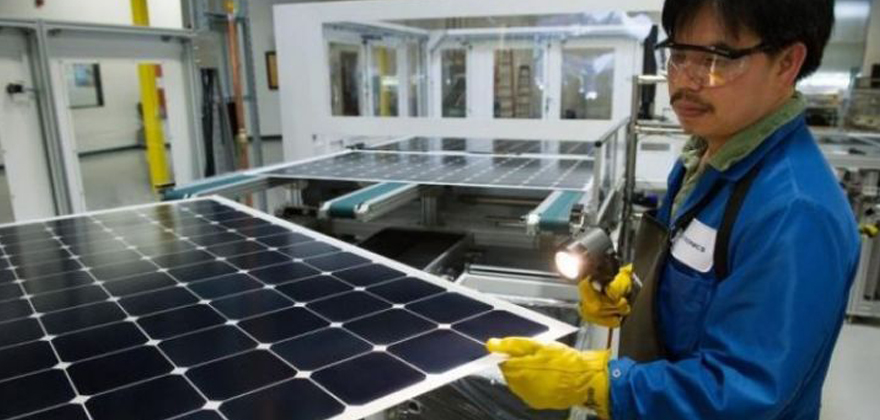Several solar manufacturers are making expansion plans. But that may not be enough to see companies “coming back strong”—as the president promised.
As a broad cross-section of the U.S. solar sector condemned new tariffs on imported solar cells and modules this week, President Trump insisted they would spur new American jobs.
“Our action today helps to create jobs in America for Americans,” he said at a televised signing ceremony in the Oval Office on Tuesday. “We’ll be making solar products now much more so in the United States. Our companies have been decimated, and those companies are going to be coming back strong.”
Numerous trade experts, policymakers and industry analysts believe that’s just not true. The Solar Energy Industries Association (SEIA) calculates the trade remedies will trigger 23,000 job losses this year across the broader solar industry, which currently employs some 260,000 workers. The Wall Street Journal Editorial Board wrote this week that, “Mr. Trump’s tariffs are an economic blunderbuss that will hit America’s friends abroad and Mr. Trump’s forgotten men and women at home.”
But some recent announcements indicate that the president’s comments might not be entirely off base.

DOE introduces the "American Made Solar Prize"
For one thing, the Department of Energy’s Solar Energy Technologies Office (SETO) announced a $3 million in prize competition on Wednesday to “reenergize innovation” in U.S. solar manufacturing. The American Made Solar Prize is designed to “incentivize the nation’s entrepreneurs to develop new processes and products that will reassert American leadership in the solar marketplace,” according to a press release.Sign up for the GTM newsletter. Stay up to date on all the latest! TOP ARTICLESMOST POPULAR MOST COMMENTSTrump Administration Issues 30% Solar Panel Import TariffThe Next 5 Years in Energy Storage, According to 500 Energy ProfessionalsTrump’s Solar Tariffs: We Answer Your QuestionsWHITE PAPERSThe Next Five Years in Energy Storage According to 500 Energy ProfessionalsDOWNLOAD >Utility Scale Central Inverters: Features That Matter and Best PracticesDOWNLOAD >Research Note - Module Procurement Trends in the U.S. Residential MarketGET REPORT NOW >U.S. Solar Outlook Under Section 201: Supply and Demand Impacts of Tariffs at $0.10/W IncrementsGET REPORT NOW >The program will leverage the testing and development capabilities of DOE’s 17 national labs, and facilitate connections with both corporate and venture capital sources to help lower the barriers American innovators face in reaching manufacturing scale.
“The United States possesses the talent, expertise, and vision to surpass the rest of the world in solar technologies and forge a new solar energy landscape around the globe,” said Energy Secretary Rick Perry, in a statement. “The American Made Solar Prize will galvanize our country’s entrepreneurs, allow them to utilize technologies and innovations developed through DOE’s early-stage research and development, and, ultimately, bring new American-made products to market.”
As the administration seeks to support the country’s long-term manufacturing capabilities, Trump’s newly released solar tariffs could also give a boost manufacturing output -- and jobs -- nearer term.
Module makers ramp up U.S. manufacturing
The day Trump signed the proclamation on new solar tariffs, Texas-based solar module manufacturer Mission Solar Energy announced that it’s ramping up production to meet 2018 demand. The company -- which had to layoff workers in early 2017 -- is also hiring 50 new employees to shift production line operations to a 24/7 schedule and stated this is just “the first phase in the plan for production increase.”
On January 11, California-based Solaria Corporation announced it had raised $23 million in growth funding from a syndicate of leading strategic and financial investors to expand its manufacturing capacity in the U.S. and, eventually, around the world. The funding wasn’t explicitly tied to the tariff announcement, but the advantage of selling tariff-free panels couldn’t have hurt Solaria’s business case.
Domestic solar module makers in particular have been bolstered by the president’s decision to allow for 2.5-gigawatts of tariff-free solar cells to be imported each year, for the four-year duration of the trade remedy. A group of 10 American crystalline-silicon solar PV (CSPV) module manufacturers, including Mission Solar and Solaria, as well as Tesla, urged the president to implement a trade remedy that would allow for enough tariff-free solar cells to support and grow the domestic solar module manufacturing industry -- and they effectively got their wish.

Text and pictures come from the web
Copyright to original author all rights reserved



